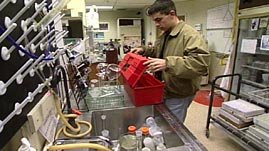Started by high school science teacher Bob Madar as a dropout prevention program in 1989, Field Biology has grown into an intensive, two-year, project-based biology course that now attracts students from all academic levels. Program students spend their first year acquiring a firm base of biological knowledge, scientific research experience, and fieldwork skills. Then, in the second year, they operate primarily in the field. Working with professional scientists from area environmental labs, they conduct research and develop projects that are of particular interest to them as well as beneficial to the local community.
In the eleventh grade, students take General Field Biology (GFB) to get a foundation in ecological theory and principles and learn field methods to prepare them for their project-oriented second year. They learn the language of the discipline and become comfortable hearing and using scientific vocabulary. The outdoor environment is the classroom laboratory, and the students work as ecological scientists almost right from the start.
In the twelfth grade, students take Advanced Field Biology (AFB), which is a project-based approach to learning. Students are expected to: 1) complete an authentic project that meets a real community need; 2) work with adult experts from outside the school; and 3) draw on a variety of content areas to complete their work (for example, math, writing, research methods, various scientific disciplines, use of technology, and so on). To achieve these ends, students meet state standards, provide a useful service to the community, and collaborate with a working scientist or land manager. They also work as field scientists, which is what the entire second year is all about.
Advanced Field Biology is primarily a student-driven course. Students design the content and make the important decisions about course structure and assessment. The students' mentors are the content experts for Advanced Field Biology. The teacher is more a pedagogical expert, advising the mentors on effective ways to help students learn.

 Loading Standards
Loading Standards Teachers' Domain is proud to be a Pathways portal to the National Science Digital Library.
Teachers' Domain is proud to be a Pathways portal to the National Science Digital Library.
